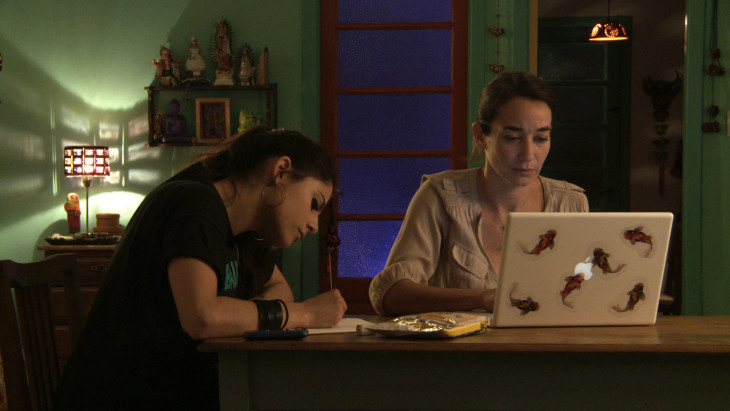Part of Cinematheque’s recent Latin American, Caribbean & Iberian Studies programming, Adriano Salgado’s debut, Use of a Magazine Rack [La utilidad de un revistero] (2014), is cinema as postmodern theatre. In addition to recalling fellow Argentine Matías Piñeiro, who shares a fondness for the intermingling of film and theatrical mediums in the recent Viola (2012), Salgado’s film harnesses the disciplines of directors Chantal Akerman (in its setting and measured progression), Richard Linklater (intimate dialogue, implementation of time), and Alain Resnais (fourth wall-breaking theatrics).
Established in a single stationary shot from a camera that faces an apartment’s living room table, Use of a Magazine Rack cleverly devises motivations for its co-leading actresses to roam the on- and off-screen spaces, manipulating both commonplace and unique objects that alter the aesthetic and mood, effectively providing a transportive illusion. The accumulating effect of these tangible rearrangements proves that simplicity of direction with a robust thematic premise and shrewd self-awareness can yield a cinematic lure as potent as any choppy, run-of-the-mill action-thriller. In this film, just like Alexander Sokurov’s gorgeously choreographed Russian Ark (2002), famously made in just one kinetic take through the halls of the Hermitage Museum in St. Petersburg, Russia, no trips to the editing room are required for a remarkably layered presentation.
Guided exclusively by two women, professional theatre director Ana (María Ucedo) and the younger, punkishly dressed artist Miranda (Yanina Gruden), this informal interview-turned-intimate inquiry begins with a bit of small talk about a leaky ceiling and admiration for Michael Mann’s Collateral (2004) before diving into the creative project at-hand that doubles for this film’s own setup: a modern urban interpretation of Little Red Riding Hood. Ana’s scaled model of the set, reflective of the film’s own mise-en-scène, serves to outline the events of the play that are reenacted with nearby props including a few miniature bottles of liquor and nail polish. As Ana moves the bottles like chess pieces through the open contours of the diorama, she directs Miranda to dangle a flashlight over them to mimic stage spotlighting. This sequence immediately highlights Selgado’s unconventional meta-experiment with the two women acting as surrogate co-directors. Their investments in the nuances of performance and rhythms of conversation facilitate the film’s multidimensional glimpses into art and life that another film may have heavily censored to advance the plot.
Its imaginative techniques are further augmented by the fact that, within a still frame without zooms, Use of a Magazine Rack delights in consciously withholding information from the viewer. Positioning Miranda’s portfolio drawings and Ana’s MacBook screen out of view, the film often relies upon sound to conjure intrigue. Remarks about the space of the apartment outside the frame are consistently instilled with a maddening curiosity; for instance, Ana notices additional ceiling leaks in the middle of a thought and suddenly springs from her chair to move a sofa and place a bowl under the dripping water. Or, comparably, Miranda gazes at the piano beyond the foreground, wandering off-screen to tickle the ivories for a few seconds before slinking back into view.
As the evening continues into its second act, Ana positions an antique mirror adorned with a fresco-like painting on the table as well as a tri-fold beach backdrop with a line-up of palm trees. After this reconfiguration, she suggests ordering empanadas; as the women bond over the comforts of the warm meal, for an instant, Ana and Miranda appear as if they are dining on an opulent patio at a resort island miles away from this presumably urban center in Argentina. The backdrop changes just as suddenly as it was revealed with Ana flipping the panels that display three elongated portraits of French actor Jean-Paul Belmondo from different periods in his career. She remarks that, collectively, the backdrop “shows the passing of time in a very wild way,” recalling an earlier moment about the role of the train on the miniature set of the Little Red Riding Hood interpretation.
With the idealistic image of masculine sexuality hovering in full view, the conversation turns to sexual history after Miranda dares Ana to participate in a seemingly innocent game of associations (perhaps, as Salgado intends, like a critic’s task). The talk is explicit but sympathetic even if its evolution is somehow awkwardly provocative from a directorial standpoint, as if it were primarily conceived as superficial stimulation for the wandering minds in the audience. However, when placed within a larger context, the confessional heart-to-heart meshes with the film’s innovative representation of the chamber play and its dialogue’s stream of consciousness.
As the night draws to a close, Ana and Miranda part ways, which leaves the nostalgic Ana alone in her sonic invocation of the past through a live-recorded performance of her ex-boyfriend’s jazz ensemble. She places the CD in a small stereo shelf system atop a bureau that’s now visible in the flipped antique mirror’s reflection, thus triggering and conveying Ana’s newly reassured identity. With a closing device lifted from the opening credits of Godard’s Contempt (1963), Use of a Magazine Rack self-satisfyingly relishes in its own “radical” modus operandi for a few minutes, which, as cinematic and theatrical history dictate, is not quite so singular. Nonetheless, the film memorably breaks the boundaries of time and space, and, in a final well-timed thrill, evokes Ana’s quote about the daring representation of time as the essence of cinema.

